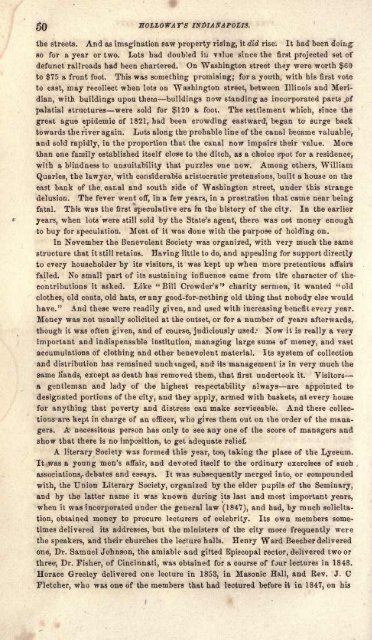Indianapolis- a historical and statistical sketch, 1870,WR Holloway
Indianapolis- a historical and statistical sketch, 1870,WR Holloway
Indianapolis- a historical and statistical sketch, 1870,WR Holloway
Create successful ePaper yourself
Turn your PDF publications into a flip-book with our unique Google optimized e-Paper software.
50<br />
BOLLOWATS INDIAXAPOtlS.<br />
the streets. And as imagination saw property rising, it did rise. It had been doing'<br />
so for a year or two. Lots had doubled in value since the first projected set of<br />
defunct railroads had been chartered. On Washington street they were worth $69<br />
to $75 a front foot. This was something promising; for a youth, with his first vote<br />
to cast, may recollect when lots on Washington street, between Illinois <strong>and</strong> Meri-<br />
dian, with buildings upon them buildings now st<strong>and</strong>ing as incorporated parts .of<br />
palatial structures were sold for $120 a foot. The settlement which, since the<br />
great ague epidemic of 1821, had been crowding eastward, began to surge back<br />
towards the river again. Lots along the probable line of the canal became valuable,<br />
<strong>and</strong> sold rapidly, in the proportion that the canal now impairs their value. More<br />
than one family established itself close to the ditch, as a choice spot for a residence,<br />
with a blindness to unsuitability that puzzles one now. Among others, William<br />
Quarles, the lawyer, with considerable aristocratic pretensions, built a house on the<br />
east bank of the. canal <strong>and</strong> south side of Washington street, under this strange<br />
delusion. The fever went off, in a few years, in a prostration that came near being<br />
fatal. This was the first speculative era in the history of the city. In the earlier<br />
years, when lots were still sold by the State's agent, there was not money enough<br />
to buy for speculation. Most of it was done with the purpose of holding on.<br />
In November the Benevolent Society was organized, with very much the same<br />
structure that it still retains. Having little to do, <strong>and</strong> appealing for support directly<br />
to every householder by its visitors, it was kept up when more pretentious affairs<br />
failed. No small part of its sustaining influence came from th"e character of ths<br />
contributions it asked. Like "Bill CrowderV' charity sermon, it wanted "old<br />
clothes, old coats, old hats, or any good-for-rrothing old thing that nobody else would<br />
have." And these were readily given, <strong>and</strong> used with increasing benefit every year.<br />
Money was not usually solicited at the outset, or for a number of years afterwards,<br />
though it was often given, <strong>and</strong> of course, judiciously used.- Now it is really a very<br />
important <strong>and</strong> indispensable institution, managing large sums of money, <strong>and</strong> vast<br />
accumulations of clothing <strong>and</strong> other benevolent material. Its system of collection<br />
<strong>and</strong> distribution has remained unchanged, <strong>and</strong> its management is in very much the<br />
same H<strong>and</strong>s, except as death has removed them, that first undertook it. Visitors<br />
a gentleman <strong>and</strong> lady of the highest respectability always are appointed t<br />
designated portions of the city, <strong>and</strong> they apply, armed with baskets, at every house<br />
for anything that poverty <strong>and</strong> distress can make serviceable. And these collec-<br />
tions- are kept in charge of an officer, who gives them out on the order of the managers.<br />
A- necessitous person has only to see any one of the score of managers <strong>and</strong><br />
show that there is no imposition, to get adequate relief.<br />
A literary Society was formed this year, too, taking the place of the Lyceum.<br />
It was a young men's affair, <strong>and</strong> devoted itself to the ordinary exercises of such<br />
associations, debates <strong>and</strong> essays.<br />
It was subsequently merged into, or compounded<br />
with, the Union Literary Society, organized by the elder pupils of the Seminary,<br />
<strong>and</strong> by the latter name it was known during its last <strong>and</strong> most important years,<br />
when it was incorporated under the general law (1847), <strong>and</strong> had, by much solicita-<br />
tion, obtained money to procure lecturers of celebrity. Its own members sometimes<br />
delivered its addresses, but the ministers of the city more frequently were<br />
the speakers, <strong>and</strong> their churches the lecture halls. Henry Ward Beecher delivered<br />
one, Dr. Samuel Johnson, the amiable <strong>and</strong> gitted Episcopal rector, delivered two or<br />
three, Dr. Fisher, of Cincinnati, was obtained for a course of fjur lectures in 1848.<br />
Horace Greeley delivered one lecture in 1853, in Masonic Hall, <strong>and</strong> Rev. J. C<br />
Fletcher, who was one of the members that had lectured before it in 1847, on his


